Japanese-British writer Kazuo Ishiguro is not very fond of critics concentrating on Japanese elements in his works , however, his first short stories and the following two novels take place – even if, as it is the case with A Pale View of Hills, only partly– in Japan, making it hard not to concentrate on the writer´s apparent preoccupation with his Japanese heritage. His third novel, featuring an English setting and characters – an old mansion, a butler, and his employer, may have been viewed as an attempt to break away from this line of interpretation on the one hand, on the other, however, it was the one work which first merited a mention of the similarities between the butler´s philosophy of life and the samurai code of honour. To the author, though, his three novels, namely A Pale View of Hills, An Artist of the Floating World, and The Remains of the Day, are linked primarily by their characters, who all seem to be stuck in similar situations, having to face their past – in all three cases the past ultimately revolves around their choices before, during and in the immediate aftermath of the Second World War – and consequently struggle with their long-repressed feelings of regret and even shame...
Table of Contents
1. Introduction
2. Samurai Ethics in the Novels of Kazuo Ishiguro
2.1. Samurai Ethics – An Overview
2.2. The Position of Woman – Ishiguro’s Female Characters
2.3. Suicide
2.4. The Duty of Loyalty
2.4.1. Filial Piety
2.4.2. Teacher-Student relationship
2.4.3. Loyalty to the Master
2.4.4. Serving a Higher Purpose
2.5. Self-Control
2.6. Ishiguro’s Imaginary Homeland(s)
3. Conclusion
4. Bibliography
Inhaltsverzeichnis (Table of Contents)
- Introduction
- Samurai Ethics in the Novels of Kazuo Ishiguro
- Samurai Ethics - An Overview
- The Position of Woman – Ishiguro's Female Characters
- Suicide
- The Duty of Loyalty
- Filial Piety
- Teacher-Student relationship
- Loyalty to the Master
- Serving a Higher Purpose
- Self-Control
- Ishiguro's Imaginary Homeland(s)
- Conclusion
Zielsetzung und Themenschwerpunkte (Objectives and Key Themes)
This essay aims to explore the influence of samurai ethics on the works of Kazuo Ishiguro, particularly his novels and short stories. It examines how the characters in these narratives grapple with outdated moral values and their implications in a world undergoing significant societal change, particularly in the aftermath of World War II. The essay focuses on specific key values within bushidō, a code of conduct associated with samurai, and their relevance to Ishiguro's characters.
- The influence of samurai ethics on the characters and themes in Ishiguro's works.
- The tension between traditional samurai values and evolving societal norms in post-war Japan.
- The role of filial piety, loyalty, and self-control in shaping the characters' actions and motivations.
- The impact of the Second World War on individual and societal values.
- Ishiguro's portrayal of "imaginary Japan" and its connection to samurai ethics.
Zusammenfassung der Kapitel (Chapter Summaries)
The introduction establishes the context for examining the influence of samurai ethics in Ishiguro's works. It highlights Ishiguro's apparent preoccupation with his Japanese heritage and his interest in characters grappling with the past, particularly their choices during and after World War II.
The first chapter provides an overview of samurai ethics, focusing on the concept of bushidō and its historical development. It delves into the evolution of this code of conduct and its significance in Japanese society, exploring the contributions of various scholars and their interpretations.
Schlüsselwörter (Keywords)
Key terms and concepts explored in this essay include: Kazuo Ishiguro, samurai ethics, bushidō, Japanese culture, World War II, filial piety, loyalty, self-control, Hagakure, The Remains of the Day, A Pale View of Hills, An Artist of the Floating World, “imaginary Japan,” and post-war Japan.
- Citar trabajo
- Lynn Bay (Autor), 2010, Samurai Ethics in the Works of Kazuo Ishiguro, Múnich, GRIN Verlag, https://www.grin.com/document/202938



